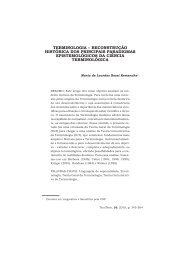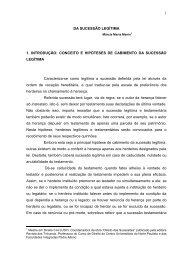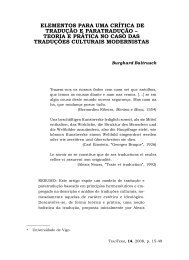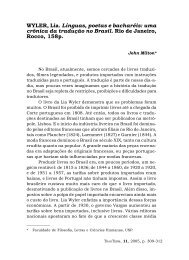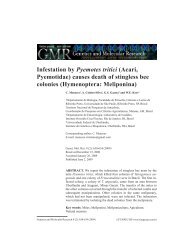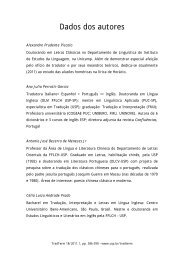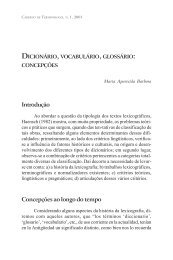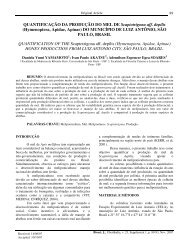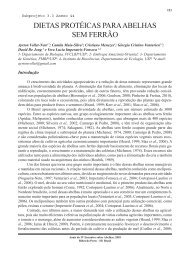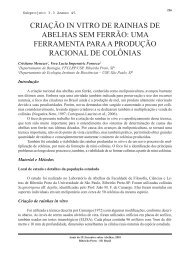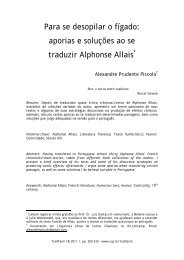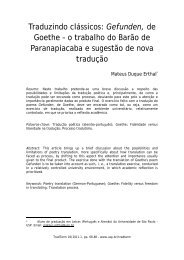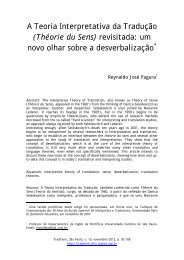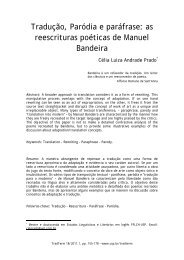Bees as pollinators in Brazil - USP
Bees as pollinators in Brazil - USP
Bees as pollinators in Brazil - USP
Create successful ePaper yourself
Turn your PDF publications into a flip-book with our unique Google optimized e-Paper software.
26<br />
The poll<strong>in</strong>ation crisis and<br />
the need for surveys<br />
and monitor<strong>in</strong>g programs<br />
The impact of deforestation, habitat fragmentation,<br />
<strong>in</strong>troduction of exotic species and<br />
unfriendly agricultural practices is believed to be<br />
caus<strong>in</strong>g a decre<strong>as</strong>e <strong>in</strong> wild poll<strong>in</strong>ator populations.<br />
This, <strong>in</strong> turn, is suspected to be the cause<br />
of low fruit and seed productivity <strong>in</strong> many crop<br />
plants, with economic consequences <strong>in</strong> many<br />
parts of the world. Also the productivity of wild<br />
plants may be affected, and this can lead to<br />
local ext<strong>in</strong>ction of populations of those plants,<br />
<strong>as</strong> well <strong>as</strong> of the animals depend<strong>in</strong>g on them.<br />
S<strong>in</strong>ce this “poll<strong>in</strong>ation crisis” w<strong>as</strong> recognized,<br />
much effort h<strong>as</strong> been put <strong>in</strong>to <strong>in</strong>itiatives<br />
to conserve and susta<strong>in</strong>ably use wild <strong>poll<strong>in</strong>ators</strong>.<br />
However, it is widely recognized that we<br />
lack much of the knowledge we need to propose<br />
effective actions to achieve conservation<br />
and management practices. We are not even<br />
certa<strong>in</strong> about the geographic extension and<br />
<strong>in</strong>tensity of poll<strong>in</strong>ator population decre<strong>as</strong>es.<br />
We also lack b<strong>as</strong>ic <strong>in</strong>formation on how the different<br />
factors affect wild populations of flower<br />
visit<strong>in</strong>g organisms.<br />
Two b<strong>as</strong>ic questions stand out <strong>as</strong> be<strong>in</strong>g of<br />
surmount importance for any conservation or<br />
susta<strong>in</strong>able management <strong>in</strong>itiative to succeed:<br />
1) which poll<strong>in</strong>ator species exist <strong>in</strong> any given<br />
place? 2) how are their populations fluctuat<strong>in</strong>g<br />
along time?<br />
For these questions to be answered, we<br />
need to <strong>in</strong>vest <strong>in</strong> poll<strong>in</strong>ator faunistic surveys<br />
and <strong>in</strong> monitor<strong>in</strong>g programs.<br />
Results<br />
The group discussed the general structure of<br />
standard procedures to survey and monitor<br />
bees <strong>in</strong> cultivated fields and natural are<strong>as</strong>.<br />
Rationale<br />
• Data to be obta<strong>in</strong>ed by the suggested<br />
guidel<strong>in</strong>es will be used <strong>in</strong> the context of the<br />
<strong>Brazil</strong>ian Poll<strong>in</strong>ator Initiative and should be<br />
useful for other <strong>in</strong>itiatives around the world.<br />
• As there are countries and regions with practically<br />
no <strong>in</strong>formation about poll<strong>in</strong>ator fauna,<br />
three strategies for poll<strong>in</strong>ator <strong>in</strong>vestigation<br />
were addressed: 1) rapid <strong>as</strong>sessments; 2) surveys<br />
and 3) monitor<strong>in</strong>g programs.<br />
Recommendations<br />
B<strong>as</strong>ic pr<strong>in</strong>ciples<br />
The group agreed that suggested actions should:<br />
• Assure data quality, i.e., data must be reliable<br />
and adequate for statistical analyses.<br />
• Be realistic, consider<strong>in</strong>g time, personnel and<br />
costs constra<strong>in</strong>ts.<br />
• Be flexible enough to be applied <strong>in</strong> different<br />
environments.<br />
• Be question oriented.<br />
Difficulties<br />
Members of the group suggested and discussed<br />
various methods <strong>in</strong> use across the world.<br />
Different people had different experiences with<br />
different methods. For example, some had very<br />
good results <strong>in</strong> us<strong>in</strong>g pan traps for collect<strong>in</strong>g<br />
bees, while others obta<strong>in</strong>ed meager data from<br />
their use. Such differences could be due to different<br />
designs, different environmental conditions,<br />
etc. It became obvious that no rigid protocol<br />
could be built that could be recommended<br />
for all situations across the world; even with<strong>in</strong><br />
<strong>Brazil</strong>; the group w<strong>as</strong> not able to decide on<br />
specific methods to be employed, due to the<br />
vary<strong>in</strong>g op<strong>in</strong>ions on their efficiency.<br />
Thus, it w<strong>as</strong> decided that only general<br />
guidel<strong>in</strong>es would be built, so that data<br />
obta<strong>in</strong>ed from surveys and monitor<strong>in</strong>g programs,<br />
us<strong>in</strong>g any comb<strong>in</strong>ation of the suggest-



